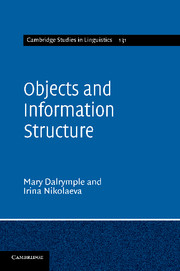Book contents
- Frontmatter
- Contents
- Preface and Acknowledgements
- List of Abbreviations
- 1 Introduction
- 2 Syntactic assumptions
- 3 Information structure in grammar
- 4 Syntax and information structure
- 5 Topicality and grammatical marking
- 6 Topical marking of nonsubjects
- 7 Topicality and DOM
- 8 Primary and secondary objecthood and DOM
- 9 Multiple objects and grammatical alignment
- 10 Semantic features, topicality and grammaticalisation
- 11 Conclusion
- References
- Author Index
- Language Index
- Subject Index
4 - Syntax and information structure
Published online by Cambridge University Press: 05 October 2012
- Frontmatter
- Contents
- Preface and Acknowledgements
- List of Abbreviations
- 1 Introduction
- 2 Syntactic assumptions
- 3 Information structure in grammar
- 4 Syntax and information structure
- 5 Topicality and grammatical marking
- 6 Topical marking of nonsubjects
- 7 Topicality and DOM
- 8 Primary and secondary objecthood and DOM
- 9 Multiple objects and grammatical alignment
- 10 Semantic features, topicality and grammaticalisation
- 11 Conclusion
- References
- Author Index
- Language Index
- Subject Index
Summary
Chapter 2 showed that patterns of agreement and casemarking are often definable in terms of purely syntactic criteria — verbs may obligatorily agree with their subjects, for example — but that criteria for marking may also refer to other, nonsyntactic levels of representation. LFG's projection architecture (Kaplan 1987) allows reference not only to the syntactic levels of c-structure and f-structure but also to other linguistic levels and the relations among them. Our investigation centres on the role of information structure in regulating object marking patterns; here we discuss the representation and formal treatment of information structure and its relation to other levels of grammar. We rely on Mycock's (2009) insight that the traditional semantic structure of LFG, an important component of the “glue” approach to the syntax-semantics interface (Dalrymple 1999, 2001, Asudeh 2004), plays a central role in representing information structure relations.
Alternative views of information structure
Various views of the representation of information structure and its relation to other grammatical modules have been proposed. Here we review some of these views, including early work within LFG.
Tree-based representations
It is well known that word order and phrasal configuration are important in encoding information structure. Within LFG, the relation between phrase structure position and information-structure role has been explored in detail by, among many others, Choi (1999), Butt and King (1996, 2000), and Mycock (2006).
Information
- Type
- Chapter
- Information
- Objects and Information Structure , pp. 58 - 93Publisher: Cambridge University PressPrint publication year: 2011
